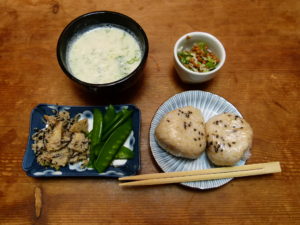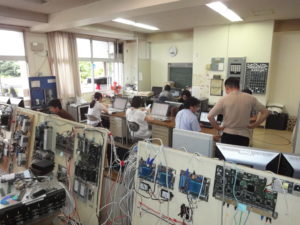Interview with Manuel M. Lopez, Former Ambassador of the Republic of the Philippines to Japan
CONTENTS
- Can you give us your general impression of Japanese people?
- How about society?
- Is there any particular aspect of Japanese culture that you like?
- Which prefectures do you like the most?
- Have you ever been to the Tohoku area where the earthquake of 3.11 occurred?
- How did you feel when you saw the disaster-stricken area?
- The business between the Philippines and Japan
- How do you yourself and the average Filipino think of Japanese companies?
- What was the result of adapting kaizen?
- How about the issue of nurses and caregivers under the EPA agreement with Japan?
- How do you want to develop bilateral relations?
Profile: Ambassador Manuel M. Lopez presented his credentials as Philippine Ambassador to Japan to H.M. Emperor Akihito on April 7, 2011. He used to be Chairman and Chief Executive Officer of the Manila Electric Company (MERALCO) from 2001 to 2010. He holds many important business posts, including chairmanship of the Lopez Holdings Corporation.
Can you give us your general impression of Japanese people?
First of all, Japanese people are disciplined. This was the biggest impression Japan made on me. I arrived here just before March 11, 2011, when the Great East Japan Earthquake occurred, and I saw the discipline demonstrated by Japanese people first hand. Because of the disaster, there was a fear of water shortages. But people lined up patiently at the supermarkets or convenience stores to get the two bottles of water quota per person at that time. There were no special privileges even for important people. Everybody lined up. It was amazing!
Although I didn’t see this myself, I was also told by some of our embassy staff that when items fell off the shelves in grocery stores during the earthquake, customers picked them up and put them back in their proper place. They were assisting the store. There was no looting following the disaster.
Before I was ambassador, I visited Japan many times on business. I would come for three or four days purely for work and then head home. My exposure to Japan was limited to the business community. I would go to offices, conference rooms or restaurants. That’s about it. But living here is different. You get to experience day-to-day occurrences. There are many things I noticed only after I came here to live.
How about society?
It is very predictable. I can tell my wife, “I will pick you up in 20 minutes,” and I will be there in 20 minutes, give or take a minute or so. Public transportation is really reliable, maybe because people are disciplined. The Japanese are an amazing race. This is something I like to repeat every time I talk with my friends or associates when I go back to the Philippines, because they often ask me about life in Japan.
Is there any particular aspect of Japanese culture that you like?
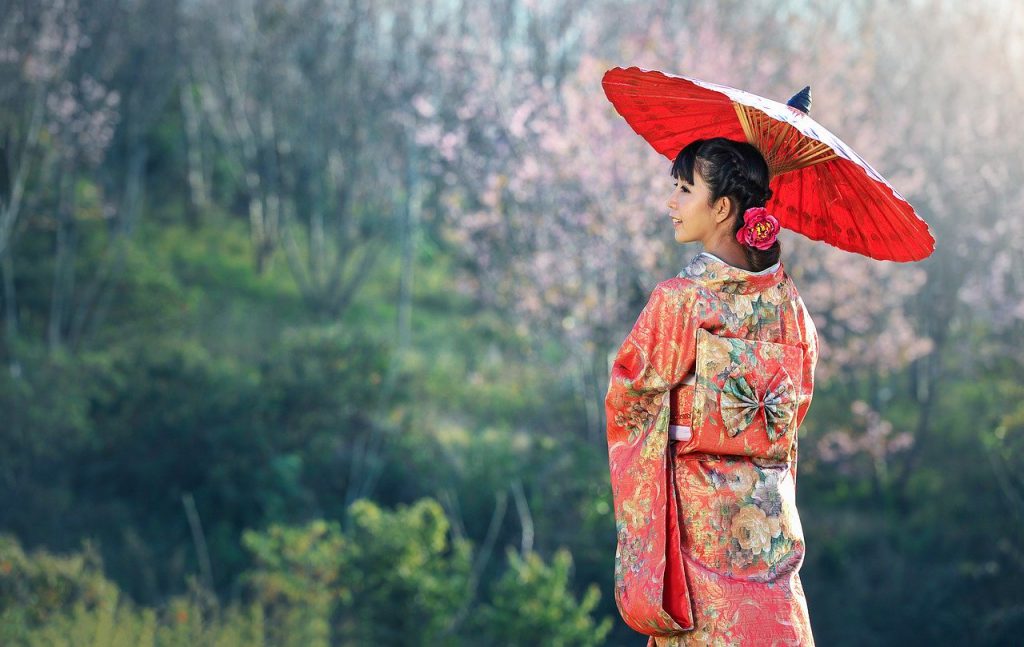
Japan is so rich in culture. It is not only cherry-blossoms or Mt. Fuji. There is so much to see and enjoy about this country. Temples and shrines are all special. Japanese women can still be seen wearing kimono (traditional Japanese clothing). My wife and I had our photo taken wearing kimono and I put it up at home. I try to soak up as much Japanese culture as I can. But there is just too much to learn.
There are 47 prefectures in Japan, but every prefecture is different from the other. Each of them has its own specialty: food, sights, and customs. It is always a treat for us to go out of town, because we know that we will experience something different.
Which prefectures do you like the most?
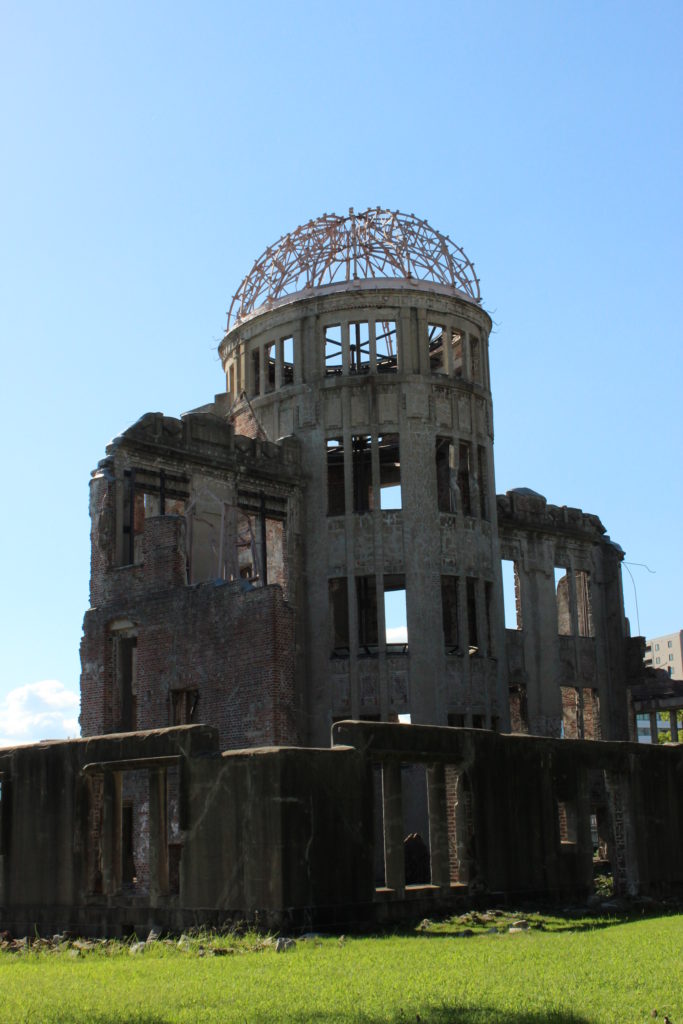
Kyoto is one of my favorite places. But what made a good impression on me was Fukuoka Prefecture. Last Golden Week[1], my wife and I joined a few friends on a cruise from Yokohama to southern Japan. In Fukuoka, we got to experience the Hakata Dontaku festival[2]. I tried various local fare such as ramen (noodles in soup), yakitori (chicken on skewers), robatayaki (grilled meat and seafood) and so on. Their dishes are very special. Fukuoka appears to have a stronger rural culture compared to Tokyo, Nagoya or Osaka. The people there seem to live a simpler life. They are not in a hurry and more relaxed.
Then of course, Nagasaki and Hiroshima are also very special. St. Lorenzo Ruiz[3], one of our Filipino saints, was martyred in Nagasaki. The city has a very strong Christian influence. You can see many Catholic churches. We went to the site where St. Lorenzo Ruiz was martyred.
In Hiroshima, it was such an experience for me to see the ravages of the Atomic Bomb at the Hiroshima Peace Memorial Park Museum. I couldn’t finish the tour. I told my wife it was too much for me to look at the people’s suffering. The photographs really showed the devastation Japan experienced.
Have you ever been to the Tohoku area where the earthquake of 3.11 occurred?
Yes. I have been to Ishinomaki, Miyagi Prefecture when our president, President Benigno S. Aquino III went there to make a donation for the reconstruction of their city. There is a Filipino community in Ishinomaki, which is largely composed of Filipino spouses of Japanese.
[1] The period from the end of April to the beginning of May, during which several national holidays are linked by one or two weekends. It is one of Japan’s three longest vacation periods.
[2] During the Dontaku Festival, many people parade through the streets in various costumes, beating drums or clapping wooden spoons for scooping rice. The festival originates from a local custom dating back to the 13th century at which the inhabitants praised the feudal lord on the occasion of New Year.
[3] San Lorenzo Ruiz was canonized by Pope John Paul II on 18 October, 1987, making him the first Filipino saint.
How did you feel when you saw the disaster-stricken area?
On September 26, 2011, Philippine President Benigno S. Aquino III visited Ishinomaki City, which was seriously damaged by the disaster, to express sympathy and make a donation of US $ 1 million toward recovery. He visited a local elementary school especially hard-hit by the tsunami and was given an explanation of the situation and plans for reconstruction. He also attended a gathering by members of the Filipino community living in the area, giving them words of encouragement.
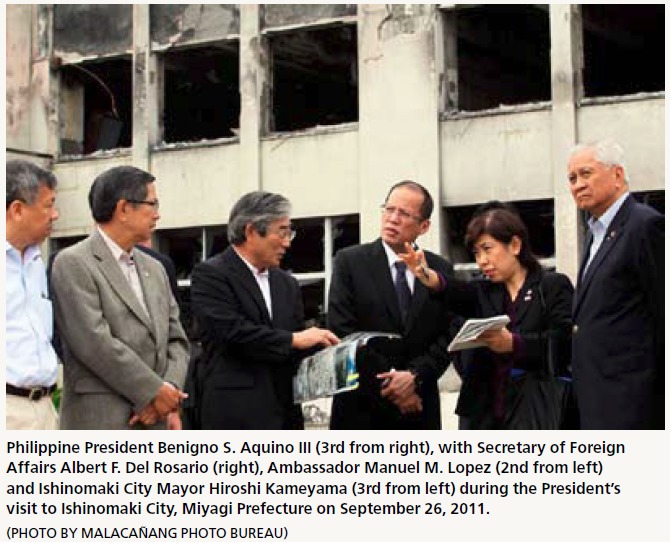
I first went there one week after the disaster, when it ws already safe to go and Japanese authorities allowed us to travel. At the beginning, you could not bring your car along the Tohoku highway because the highway might have been damaged by the earthquake. I went to see the Filipino community[4] in Sendai and Miyagi Prefecture. We brought some relief goods: water, blankets and foodstuffs to make sure they were alright. We were happy that the local government was very concerned about their welfare and safety. They took good care of our nationals, even though they were foreigners. They were welcomed in the shelters or temporary housing and treated very well. This is the reason why, when our government offered our nationals free repatriation back to the Philippines, very few decided to return. They stayed because they were satisfied with the way the local prefectural government took care of their needs.
The business between the Philippines and Japan
Let me ask you a little bit about business relations between Japan and the Philippines. Japan is the biggest trading partner of the Philippines. What do you expect from Japanese business?
We would like to further enhance business ties. I think there are still plenty of opportunities waiting for Japanese investors. We have a population of about 100 million. A big part of the population is made up of young people who are well educated and able to speak English. So we are inviting more Japanese companies to locate and invest in the Philippines. We hope we can see more Japanese investment because we offer plenty of good opportunities and advantages.
The population of the Philippines is growing at a rate of around 2%. And because of other factors in the background, like the spiraling wage increases in China and insufficient competent workforce in ASEAN, Japanese companies are re-evaluating the country and finding it suitable for new investment. In 2011, Japan was the top investor. Electronic equipment makers are the front runners, and various other industries are investing. In their investment report, many cited the large and steady workforce as the primary factor in their decision. As for bilateral trade, Japan is the Philippines’ top partner both in exports and imports. Exports are mainly electric machinery and imports are crude oil and oil products. JETRO, in a survey early this year, cited the Philippines as the top among export oriented companies operating in Asia.
How do you yourself and the average Filipino think of Japanese companies?
The Japanese have a work ethic which Filipino businessmen really appreciate. The Japanese are very hard working. In comparison, we Filipinos are a little more laid back. But the Japanese introduced a new work culture to us.
One philosophy I particularly appreciated was Konosuke Matsushita’s (1894-1989). About 20 years ago, when I was President of Manila Electric Company (MERALCO), my human resources head told me that we should now adapt a stronger work culture. She suggested kaizen[5].
“What is that?” I asked. I didn’t know about it. We invited somebody from the US, not from Japan, because at that time nobody could speak Japanese. So an instructor who had studied kaizen in Japan came and spent a week in my company.
One of the reading materials we had was The Matsushita Way . That became like a bible for the company. It was first distributed to the participants of a seminar consisting of 12 to 15 executives. After the seminar, we copied the materials and they trickled down to the lower level, the “gemba or genba” or workplace. For some managers, The Matsuhsita Way was required reading and even now, during meetings, they would refer to it. Certain expressions and words became synonymous with quality management.
Kaizen was the first way by which we embarked on our journey to achieve better productivity. After that, we learned many other models like 5S[6], TQM (Total Quality Management) and TQC (Total Quality Control). But we all started with kaizen.
What was the result of adapting kaizen?
We did a total reengineering of the company. After nine years, our workforce was down to fewer than 5,000 people from the previous 8,000. It was not that we fired people or forced them to leave. We simply did not hire new employees for a long time. Slowly, through attrition, we achieved our goal. It has been very, very successful. Because of TQM, I also gave up playing golf. My human resources head said, “You have to lead this TQM. It has to start from the top.” I had to make sacrifices because we asked our employees to make sacrifices, such as being ready to work even on weekends and staying on after 5:00 pm. They can’t leave at exactly 5 o’clock. They have to stay a little longer to develop a work habit. Of course, they can’t work too long - many of them have families who won’t allow that. But before, they would look at the time and 15 minutes before 5:00 pm, they were preparing to leave! I had to convey the idea of TQM by giving up golf.
How about the issue of nurses and caregivers under the EPA agreement with Japan?
You know, one of our hopes is that Japan and the Philippines can work together to rectify the current situation. We are ready to supply many nurses and caregivers because we have a huge pool of nurses and caregivers in the Philippines. But the problem lies in the licensing system in Japan. There are very few Filipino nurses and caregivers who can pass Japan’s national licensing examination. I was introduced to some of those who had passed, who told me the exam was very tough. Even Japanese would find it a little difficult. So we are trying to appeal to Japanese authorities to make the examination simpler, to make it something that is more related to the work, not so much to technicality.
Caring for elderly people is something innate to Filipinos. When our parents or grandparents get old, we don’t bring them to a nursing or healthcare facility. We take care of them at home. Caring is one of our core values. After the Great East Japan Earthquake, then Prime Minister Naoto Kan recognized and honored Filipino caregivers in Fukushima who didn’t leave the nursing facilities they were assigned to. They refused to abandon their elderly patients. The Philippine government also recognized them for their contributions to Japan.
The Asahi Shimbun newspaper reported on April 2, 2011 that four caregivers from the Philippines didn’t evacuate a rest home for the elderly in Shirakawa City, Fukushima even after the 3.11 disaster. One caregiver who has two sons and a husband back in the Philippines was asked by her family to return home but replied, “The elderly people depend on me. How can I leave?” The facility manager expected that all of the four would return home, but they stayed. “They are passionate, discreet and generous,” he praised them, adding “I really appreciate their work.”
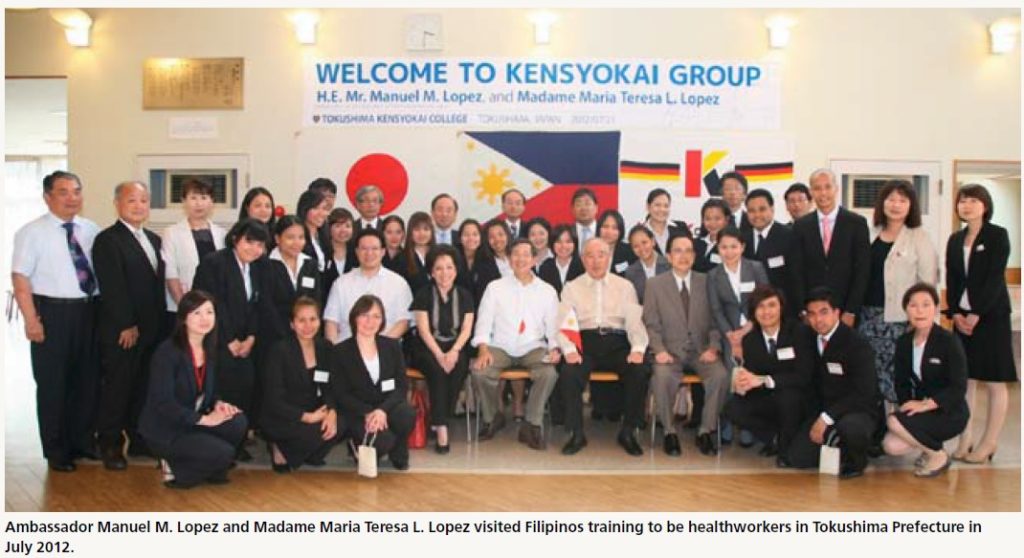
How do you want to develop bilateral relations?

There are many ways to go about it. Through trade and investment is first and foremost, but people-to-people relations are very important. Japan has many programs benefiting our young, such as The Ship for Southeast Asian Youth Program (SSEAYP) which is now on its 40th year. Over the years, the young participants of SSEAYP have done a lot of networking, and some of them have become very prominent in their respective countries. We think this kind of cultural and human exchange is very important. Japan is also sending some of its young people to the Philippines to study, volunteer or learn about the Filipino culture. These exchanges are very important because they create positive images for both countries. I want to create a good image of the Philippines so that more Japanese – from businessmen to tourists to students – will want to go to my country.
[4] According to the Statistical Handbook of Japan, at the end of 2012, 211,000 Filipinos resided in Japan, making them the third largest foreign population after Chinese and Koreans.
[5] Kaizen, Japanese for improvement, or change for the better, refers to the philosophy or practices that focus upon continuous improvement of processes in manufacturing, engineering, and business management. When used in the business sense and applied to the workplace, kaizen refers to activities that continually improve all functions, and involves all employees from the CEO to assembly line workers.
[6] The 5S methodology derives from the Japanese words Seiri, Seiton, Seiso, Seiketsu and Shitsuke, commonly referred to in English as sorting, organizing, cleaning, standardizing, and sustaining.

